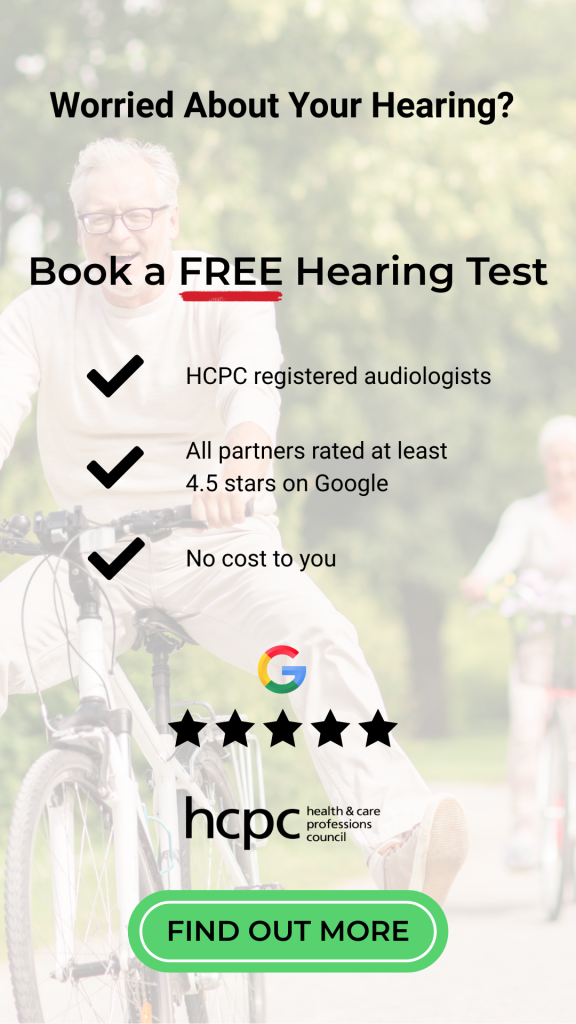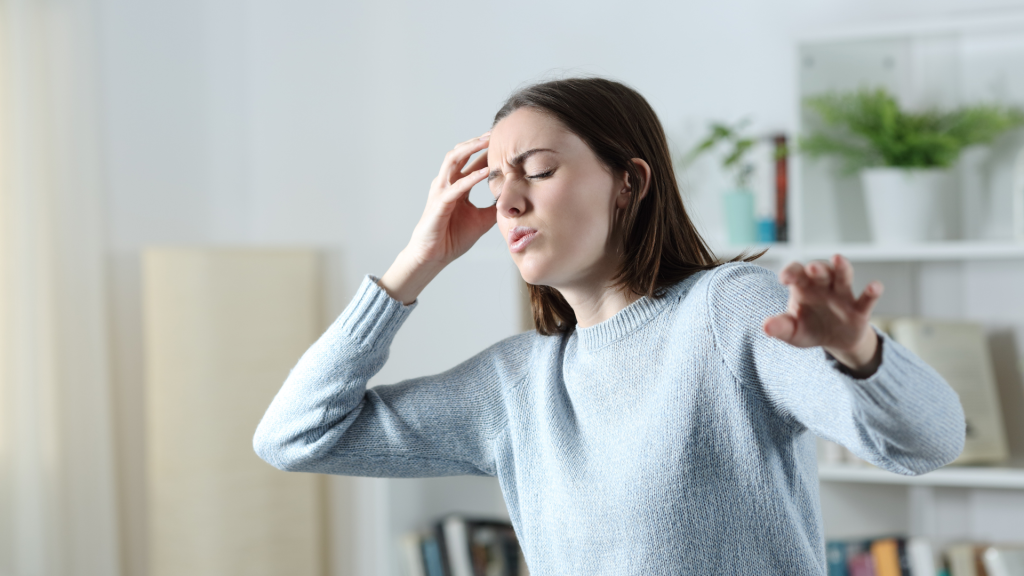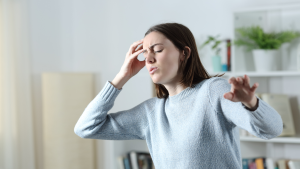Vertigo isn’t just a fleeting sensation—it can feel like the whole world is spinning, often leading to discomfort, anxiety, and even dangerous falls. For adults over 50, vertigo is a particularly common issue, often tied to changes in the inner ear or underlying medical conditions. Whether it strikes suddenly or lingers throughout the day, vertigo can significantly disrupt everyday activities and quality of life.
The good news? With the right knowledge and tools, vertigo can be managed effectively. From home strategies to professional treatments, there are many ways to reduce the intensity and frequency of episodes. Understanding your symptoms, identifying possible triggers, and taking preventive measures can make a noticeable difference.
In this article, we’ll explore what causes vertigo and how to manage it—from natural remedies and lifestyle adjustments to medical interventions. Whether you’re new to vertigo or looking for better strategies, this guide offers practical, actionable tips to help you regain balance and confidence in your daily life.
Understanding Vertigo and Its Causes
Vertigo is more than just a feeling of dizziness—it’s a specific type of disorientation where you or your surroundings seem to be spinning, tilting, or swaying. It can be brief and mild or prolonged and intense, often accompanied by nausea, balance problems, or even vomiting. Understanding what causes vertigo is a critical first step in managing it effectively.
What Is Vertigo?
Vertigo originates from a disruption in the vestibular system, the part of your inner ear and brain that helps control balance and eye movements. When this system is disturbed, your brain receives conflicting signals about your body’s position, resulting in the spinning sensation associated with vertigo.
It’s important to distinguish vertigo from general dizziness. While dizziness can refer to feeling lightheaded or faint, vertigo specifically involves a sense of movement or rotation.
Common Causes of Vertigo
Several conditions can lead to vertigo, especially in older adults:
- Benign Paroxysmal Positional Vertigo (BPPV): The most common cause of vertigo, BPPV occurs when tiny calcium particles (canaliths) move into the inner ear canals, disrupting balance signals. It often results in brief, intense episodes triggered by changes in head position.
- Meniere’s Disease: This inner ear disorder is characterized by recurrent vertigo, hearing loss, tinnitus, and a feeling of fullness in the ear. It is thought to be related to abnormal fluid buildup in the inner ear.
- Vestibular Neuritis or Labyrinthitis: These are viral infections that cause inflammation in the inner ear or the nerve that connects the inner ear to the brain. They usually cause sudden, severe vertigo and balance issues.
- Migraine-Associated Vertigo: Some people experience vertigo as part of a migraine episode, even without a headache. It can be triggered by the same factors that cause migraines, like certain foods, lights, or stress.
- Head or Neck Injury: Trauma can affect the vestibular system and lead to lingering vertigo symptoms.
- Circulatory Issues: Conditions like low blood pressure or poor blood flow to the brain can cause dizziness or vertigo, particularly when standing up too quickly.
By identifying the underlying cause of vertigo, you can better tailor your management plan and avoid potential complications.
Home Remedies and Lifestyle Adjustments
For many people, vertigo can be effectively managed with lifestyle changes and simple at-home techniques. These strategies may not cure the condition, but they can significantly reduce the frequency and severity of episodes—especially when tailored to your specific triggers and symptoms.
Be Mindful of Head Position
Certain types of vertigo, particularly BPPV, are closely tied to head movements. Sudden changes in position—such as turning over in bed or looking up quickly—can trigger an episode.
Tip: Move slowly and deliberately, especially when getting out of bed, bending over, or turning your head. Use pillows to elevate your head while sleeping.
Stay Hydrated
Dehydration can contribute to dizziness and exacerbate vertigo, especially if it’s related to blood pressure fluctuations.
Tip: Aim to drink at least 6–8 glasses of water per day. If you’re active or taking medications like diuretics, you may need more.
Watch Your Diet
Certain dietary factors may influence inner ear health and fluid balance:
- Limit sodium: Reducing salt intake can help manage Meniere’s disease by controlling fluid retention.
- Avoid caffeine and alcohol: These substances can worsen symptoms in some individuals.
- Eat regularly: Low blood sugar can cause lightheadedness, which may be confused with or contribute to vertigo.
Manage Stress
Stress and anxiety are known to aggravate vertigo, particularly in conditions like vestibular migraine and Meniere’s disease.
Tip: Incorporate relaxation techniques into your routine, such as deep breathing, yoga, meditation, or gentle stretching. Even brief daily practices can help stabilize your nervous system.
Improve Sleep Habits
Poor sleep can make you more susceptible to vertigo. Inconsistent or inadequate rest may also heighten your sensitivity to triggers.
Tip: Maintain a regular sleep schedule, limit screen time before bed, and create a calm, dark environment to promote restful sleep.
Gentle Movement and Exercise
While intense activity might not be advisable during a vertigo episode, light exercise can improve circulation and help retrain the vestibular system.
Tip: Walking, tai chi, or balance-focused exercises can help improve stability over time. Always start slowly and consult with your doctor if unsure.
Medical Treatments and Professional Therapies
When home remedies and lifestyle changes aren’t enough to manage vertigo, medical intervention can offer significant relief. The type of treatment you receive often depends on the underlying cause of your vertigo. Fortunately, there are several effective clinical options available.
Vestibular Rehabilitation Therapy (VRT)
VRT is a specialized form of physical therapy designed to retrain the brain to compensate for inner ear imbalances. It involves a series of customized exercises that improve balance, reduce dizziness, and minimize motion sensitivity.
Who it helps: Ideal for people with vestibular neuritis, labyrinthitis, and persistent balance issues.
What to expect: You’ll work with a trained therapist on eye, head, and body movements that gradually increase in difficulty. Over time, these exercises can lead to lasting improvements in stability and confidence.
The Epley Maneuver
This is a simple, highly effective treatment for BPPV. The Epley maneuver involves a series of specific head and body movements that help reposition the calcium crystals in your inner ear, allowing them to move out of the balance canals and stop triggering vertigo.
Who it helps: Especially effective for people diagnosed with BPPV.
Where it’s done: Often performed in a clinic, but many patients are taught how to do it at home under professional guidance.
Medications
In some cases, medications may be prescribed to help control vertigo symptoms:
- Antihistamines (like meclizine) or anticholinergics can reduce dizziness and nausea.
- Benzodiazepines may be used short-term for severe episodes, but they carry risks of dependence and drowsiness.
- Diuretics are sometimes prescribed for Meniere’s disease to reduce inner ear fluid.
- Migraine medications may be helpful if vertigo is associated with vestibular migraine.
Injections or Surgery (Rare Cases)
For chronic, debilitating vertigo that doesn’t respond to other treatments—such as severe Meniere’s disease—more aggressive options may be considered:
- Injections of steroids or gentamicin into the middle ear to reduce inner ear activity.
- Surgical interventions like endolymphatic sac decompression or labyrinthectomy may be options in extreme cases.
When to See a Specialist
You should consult an ENT (ear, nose, and throat doctor) or a neurologist if:
- Your vertigo is sudden and severe
- You experience hearing loss, ringing in the ears, or double vision
- Symptoms are frequent or getting worse
- You’ve had a recent head injury
Professional evaluation ensures accurate diagnosis and allows for a targeted treatment plan. Vertigo isn’t a condition you have to “just live with”—there are solutions that can restore comfort and safety.
Preventing Falls and Staying Safe
One of the greatest risks associated with vertigo—especially in older adults—is the potential for falls. Even a brief dizzy spell can result in serious injury. That’s why safety planning is an essential part of managing vertigo. By taking a few proactive steps, you can reduce your risk and maintain greater independence and confidence in your daily activities.
Make Your Home Safer
Your home should be a secure environment where vertigo episodes are less likely to cause harm.
Tips:
- Install grab bars in bathrooms and next to stairs.
- Use non-slip mats in the shower and on smooth floors.
- Remove tripping hazards like loose rugs, cords, and clutter.
- Keep walkways well-lit, especially at night.
Use Assistive Devices if Needed
There’s no shame in using tools to help you stay steady. A cane or walker can provide added balance, especially during times when vertigo symptoms are more pronounced.
Tip: Ask a physical therapist for guidance on choosing and using the right device for your needs.
Practice Safe Movement
Certain movements can trigger vertigo or make you lose balance.
Tips:
- Rise slowly from bed or a chair.
- Avoid bending over quickly.
- Hold onto a stable surface when turning your head or changing directions.
- Sit down during activities like dressing or brushing your teeth.
Wear Proper Footwear
Good shoes can make a big difference. Choose footwear with:
- Low, sturdy heels
- Slip-resistant soles
- A secure fit to prevent wobbling or slipping
Avoid walking barefoot or in loose-fitting slippers, especially on slick floors.
Stay Prepared in Public
Navigating public spaces with vertigo requires extra awareness.
Tips:
- Use handrails when available.
- Avoid escalators and opt for elevators when possible.
- Carry a card or medical ID that explains your condition in case you need assistance.
Know When to Rest
If you feel an episode coming on, don’t push through it. Sit or lie down in a safe place, preferably with your head slightly elevated. Avoid driving or operating machinery until you’re fully recovered.
By building a safer environment and being mindful of your movements, you can significantly lower your risk of injury. Taking these precautions empowers you to manage vertigo with confidence and live as actively as possible.
Conclusion
Vertigo can be a frustrating and sometimes frightening experience, especially when it disrupts your daily life or puts you at risk for falls. But the key takeaway is this: vertigo is manageable. Whether your symptoms stem from BPPV, Meniere’s disease, vestibular neuritis, or another cause, a combination of knowledge, self-care, and professional support can make a profound difference.
By understanding the root cause of your vertigo and implementing home remedies—like mindful movement, hydration, and stress management—you can reduce the intensity and frequency of episodes. When needed, medical treatments such as vestibular rehabilitation therapy or the Epley maneuver can offer effective, long-term relief. Just as importantly, taking steps to make your environment safer ensures you can respond confidently and calmly when symptoms do arise.
You don’t have to navigate vertigo alone. Regular check-ins with your healthcare provider, consistent symptom tracking, and adjustments to your routine can lead to lasting improvements. With the right approach, it’s entirely possible to regain balance—both physically and in life.
FAQ
What’s the difference between dizziness and vertigo?
Dizziness is a general term that can describe feelings of lightheadedness, faintness, or imbalance. Vertigo, on the other hand, specifically refers to a spinning or rotating sensation—either of yourself or your surroundings—and is usually linked to inner ear issues.
What is the fastest way to relieve vertigo at home?
For certain types of vertigo, especially BPPV, the Epley maneuver can offer fast relief. Staying still, lying down with your head slightly elevated, and avoiding sudden movements can also help. Drinking water and practicing deep breathing may reduce accompanying anxiety or nausea.
Can diet affect vertigo symptoms?
Yes. A high-sodium diet can worsen Meniere’s disease symptoms, and caffeine or alcohol may trigger episodes in some people. Eating balanced, regular meals and staying well-hydrated can also support better inner ear function and blood pressure regulation.
When should I see a doctor for vertigo?
You should seek medical attention if you experience sudden, severe vertigo; frequent episodes; vertigo with hearing loss or vision changes; or symptoms after a head injury. These may indicate a more serious underlying condition that requires evaluation.
Is vertigo a lifelong condition?
It depends on the cause. Some forms of vertigo, like BPPV, can be resolved with treatment. Others, such as Meniere’s disease or vestibular migraines, may be chronic but manageable with the right combination of therapy, lifestyle adjustments, and medical care.
Disclaimer
This article is for informational purposes only and is not a substitute for professional medical advice, diagnosis, or treatment. If you are concerned about your hearing or ear health, please consult a qualified healthcare provider.






